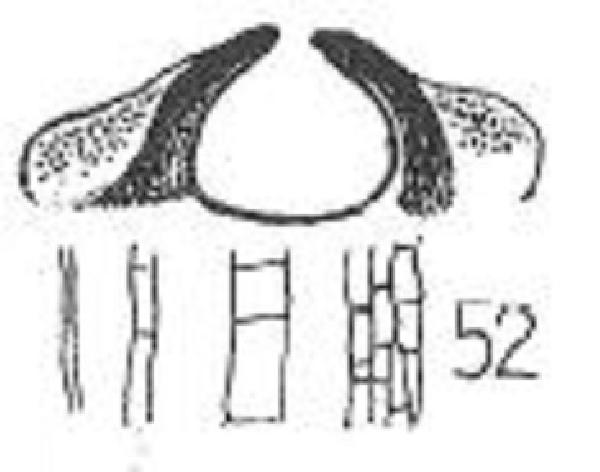Verrucaria nigrofusca Servít
Acta Mus. Nat. Pragae, 5, B, 9, Bot. 3: 38, 1949.
Synonyms: Lithoicea nigrescens var. umbrina A. Massal.; Verrucaria nigroumbrina Servít
Description: Thallus crustose, episubstratic, dull brown, continuous to rimose-areolate, 0.2-0.3 mm thick, sometimes delimited by a thin black prothallus, the areoles angular to irregular, flat, smooth, 0.2-0.5 mm wide (the fertile ones up to 0.8 mm wide), often subdivided into smaller units. Cortex poorly developed, brown in uppermost part; medulla white or patchily brown (especially around perithecia), sometimes pale brown in lowermost part, but without a black basal layer. Perithecia black, 1 per areole, almost fully immersed or hemispherically projecting, without a thalline covering. Involucrellum adpressed to exciple, extending to base-level, up to 80-100 µm thick at base; exciple subglobose to broadly pyriform, 0.2-0.3 mm across, the wall colourless to dark brown, 15-20 µm thick; hamathecium of 25-35 µm long, thin, mostly simple periphyses and periphysoids, interascal filaments absent; hymenial gel hemiamyloid, I+ red (I+ blue at very low concentrations of I), K/I+ blue. Asci 8-spored, clavate, I-, fissitunicate, the wall thickened above, with an ocular chamber, dehiscent by extrusion of an endotunica to form a delicate rostrum, Verrucaria-type. Ascospores 1-celled, hyaline, ellipsoid, 17-24 x 8-12 µm. Photobiont chlorococcoid. Spot tests: K-, C-, KC-, P-, UV-. Chemistry: without lichen substances.
Growth form: Crustose
Substrata: rocks
Photobiont: green algae other than Trentepohlia
Reproductive strategy: mainly sexual
Poorly known taxon in need of further study
Commonnes-rarity: (info)
Alpine belt: very rare
Subalpine belt: very rare
Montane belt: extremely rare
Dry submediterranean belt: absent
Humid submediterranean belt: absent
Padanian area: absent
pH of the substrata:
1 2 3 4 5
Solar irradiation:
1 2 3 4 5
Aridity:
1 2 3 4 5
Eutrophication:
1 2 3 4 5
Poleotolerance:
0 1 2 3
Altitudinal distribution:
1 2 3 4 5 6
Rarity
absent
extremely rare
very rare
rare
rather rare
rather common
common
very common
extremely common
Loading data...
Occurrence data
Predictive map
Growth form: Crustose
Substrata: rocks
Photobiont: green algae other than Trentepohlia
Reproductive strategy: mainly sexual
Poorly known taxon in need of further study
Commonnes-rarity: (info)
Alpine belt: very rare
Subalpine belt: very rare
Montane belt: extremely rare
Dry submediterranean belt: absent
Humid submediterranean belt: absent
Padanian area: absent
pH of the substrata:
| 1 | 2 | 3 | 4 | 5 |
Solar irradiation:
| 1 | 2 | 3 | 4 | 5 |
Aridity:
| 1 | 2 | 3 | 4 | 5 |
Eutrophication:
| 1 | 2 | 3 | 4 | 5 |
Poleotolerance:
| 0 | 1 | 2 | 3 |
Altitudinal distribution:
| 1 | 2 | 3 | 4 | 5 | 6 |
Rarity
absent
extremely rare
very rare
rare
rather rare
rather common
common
very common
extremely common
Loading data...
Occurrence data
Predictive map







